Intercultural Business Management: Cultural Dimensions and Strategies
VerifiedAdded on 2023/01/18
|7
|1860
|100
Report
AI Summary
This report delves into the realm of intercultural business management, emphasizing the significance of cultural dimensions in navigating the global market. It begins with an introduction to intercultural management, highlighting the role of cultural dimensions in understanding the impacts on international markets. The main body then explores various cultural dimensions, particularly focusing on Hofstede's model, with a deep dive into individualism versus collectivism and their effects on motivation and organizational behavior. The report further examines strategies for managing cross-cultural situations in the workplace, emphasizing the importance of collectivism, fostering strong relationships, embracing diversity, and utilizing individualistic approaches when necessary. The conclusion summarizes the key findings, reiterating the vital role of cultural dimensions and strategic management in achieving success in international business. The report provides insights into the complexities of international business and provides strategies for effective management.

Intercultural Business
Management
1
Management
1
Paraphrase This Document
Need a fresh take? Get an instant paraphrase of this document with our AI Paraphraser
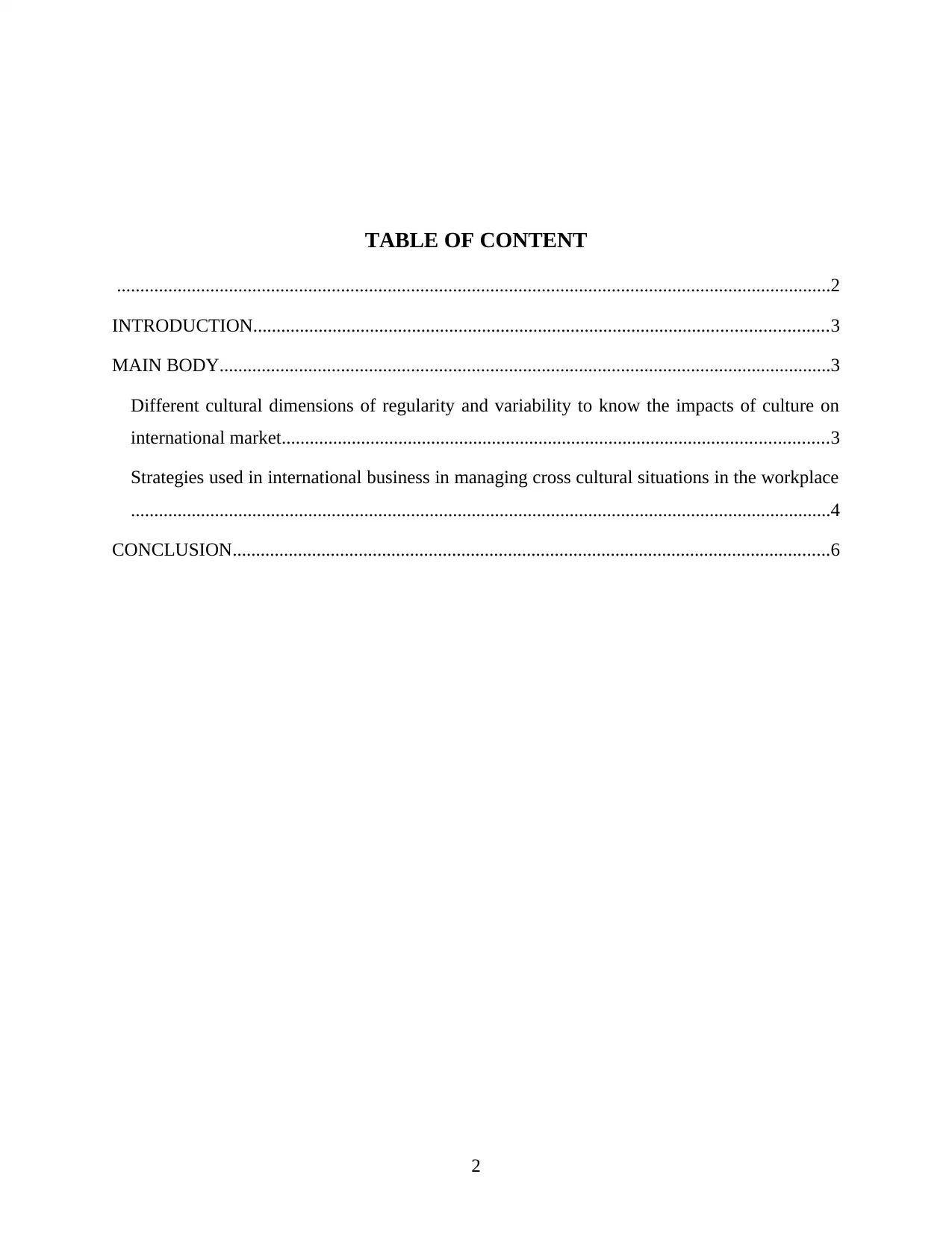
TABLE OF CONTENT
.........................................................................................................................................................2
INTRODUCTION...........................................................................................................................3
MAIN BODY...................................................................................................................................3
Different cultural dimensions of regularity and variability to know the impacts of culture on
international market.....................................................................................................................3
Strategies used in international business in managing cross cultural situations in the workplace
......................................................................................................................................................4
CONCLUSION................................................................................................................................6
2
.........................................................................................................................................................2
INTRODUCTION...........................................................................................................................3
MAIN BODY...................................................................................................................................3
Different cultural dimensions of regularity and variability to know the impacts of culture on
international market.....................................................................................................................3
Strategies used in international business in managing cross cultural situations in the workplace
......................................................................................................................................................4
CONCLUSION................................................................................................................................6
2
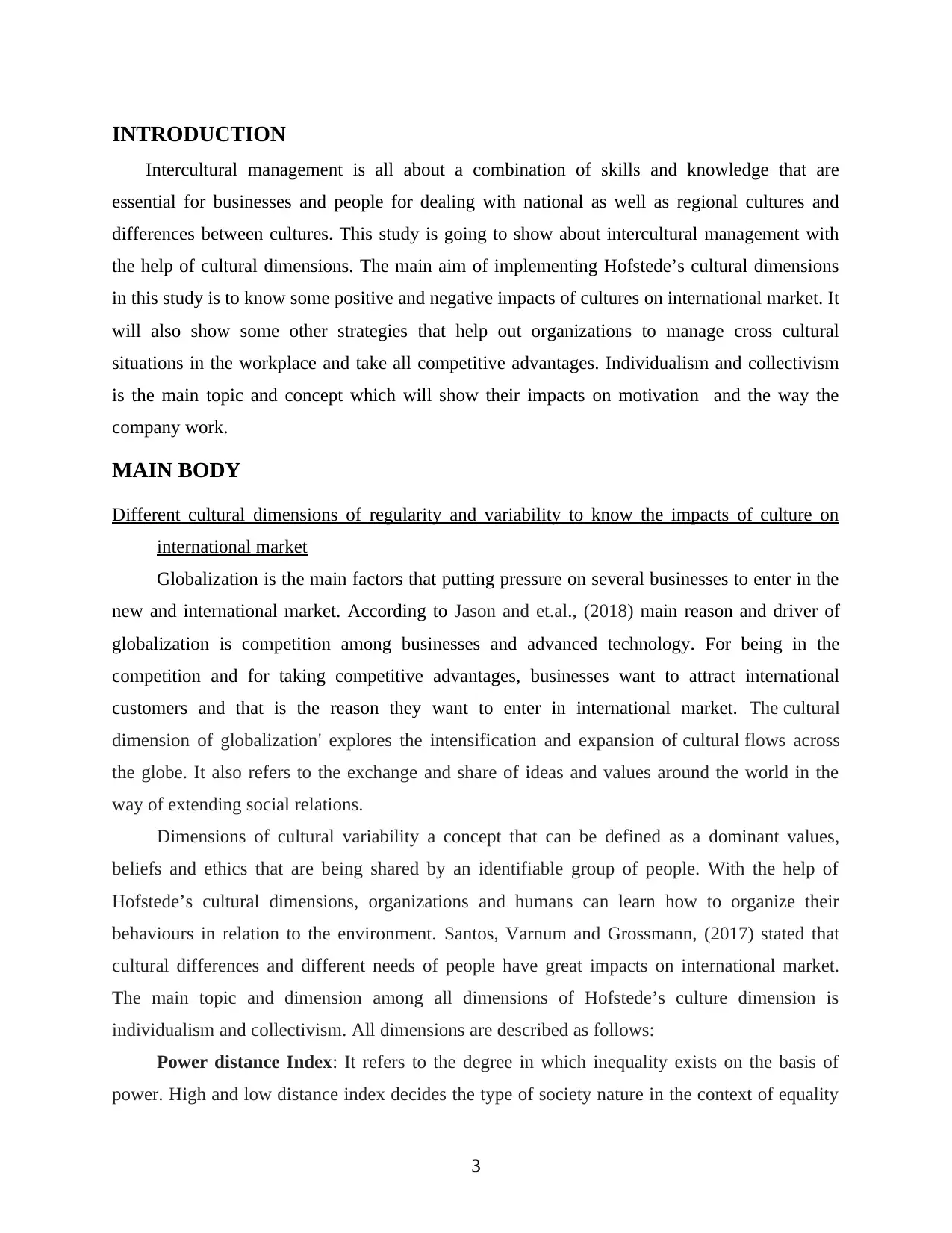
INTRODUCTION
Intercultural management is all about a combination of skills and knowledge that are
essential for businesses and people for dealing with national as well as regional cultures and
differences between cultures. This study is going to show about intercultural management with
the help of cultural dimensions. The main aim of implementing Hofstede’s cultural dimensions
in this study is to know some positive and negative impacts of cultures on international market. It
will also show some other strategies that help out organizations to manage cross cultural
situations in the workplace and take all competitive advantages. Individualism and collectivism
is the main topic and concept which will show their impacts on motivation and the way the
company work.
MAIN BODY
Different cultural dimensions of regularity and variability to know the impacts of culture on
international market
Globalization is the main factors that putting pressure on several businesses to enter in the
new and international market. According to Jason and et.al., (2018) main reason and driver of
globalization is competition among businesses and advanced technology. For being in the
competition and for taking competitive advantages, businesses want to attract international
customers and that is the reason they want to enter in international market. The cultural
dimension of globalization' explores the intensification and expansion of cultural flows across
the globe. It also refers to the exchange and share of ideas and values around the world in the
way of extending social relations.
Dimensions of cultural variability a concept that can be defined as a dominant values,
beliefs and ethics that are being shared by an identifiable group of people. With the help of
Hofstede’s cultural dimensions, organizations and humans can learn how to organize their
behaviours in relation to the environment. Santos, Varnum and Grossmann, (2017) stated that
cultural differences and different needs of people have great impacts on international market.
The main topic and dimension among all dimensions of Hofstede’s culture dimension is
individualism and collectivism. All dimensions are described as follows:
Power distance Index: It refers to the degree in which inequality exists on the basis of
power. High and low distance index decides the type of society nature in the context of equality
3
Intercultural management is all about a combination of skills and knowledge that are
essential for businesses and people for dealing with national as well as regional cultures and
differences between cultures. This study is going to show about intercultural management with
the help of cultural dimensions. The main aim of implementing Hofstede’s cultural dimensions
in this study is to know some positive and negative impacts of cultures on international market. It
will also show some other strategies that help out organizations to manage cross cultural
situations in the workplace and take all competitive advantages. Individualism and collectivism
is the main topic and concept which will show their impacts on motivation and the way the
company work.
MAIN BODY
Different cultural dimensions of regularity and variability to know the impacts of culture on
international market
Globalization is the main factors that putting pressure on several businesses to enter in the
new and international market. According to Jason and et.al., (2018) main reason and driver of
globalization is competition among businesses and advanced technology. For being in the
competition and for taking competitive advantages, businesses want to attract international
customers and that is the reason they want to enter in international market. The cultural
dimension of globalization' explores the intensification and expansion of cultural flows across
the globe. It also refers to the exchange and share of ideas and values around the world in the
way of extending social relations.
Dimensions of cultural variability a concept that can be defined as a dominant values,
beliefs and ethics that are being shared by an identifiable group of people. With the help of
Hofstede’s cultural dimensions, organizations and humans can learn how to organize their
behaviours in relation to the environment. Santos, Varnum and Grossmann, (2017) stated that
cultural differences and different needs of people have great impacts on international market.
The main topic and dimension among all dimensions of Hofstede’s culture dimension is
individualism and collectivism. All dimensions are described as follows:
Power distance Index: It refers to the degree in which inequality exists on the basis of
power. High and low distance index decides the type of society nature in the context of equality
3
⊘ This is a preview!⊘
Do you want full access?
Subscribe today to unlock all pages.

Trusted by 1+ million students worldwide
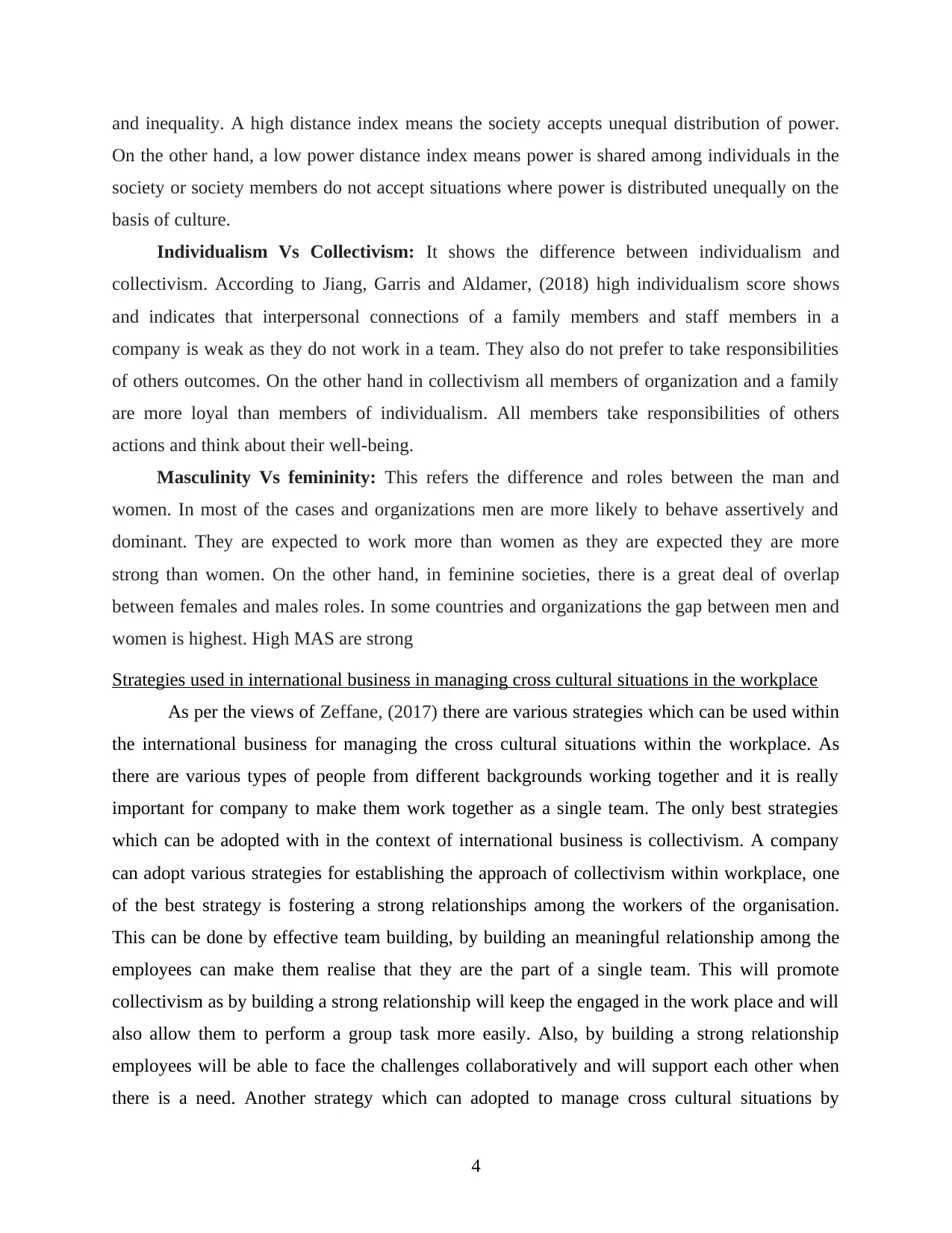
and inequality. A high distance index means the society accepts unequal distribution of power.
On the other hand, a low power distance index means power is shared among individuals in the
society or society members do not accept situations where power is distributed unequally on the
basis of culture.
Individualism Vs Collectivism: It shows the difference between individualism and
collectivism. According to Jiang, Garris and Aldamer, (2018) high individualism score shows
and indicates that interpersonal connections of a family members and staff members in a
company is weak as they do not work in a team. They also do not prefer to take responsibilities
of others outcomes. On the other hand in collectivism all members of organization and a family
are more loyal than members of individualism. All members take responsibilities of others
actions and think about their well-being.
Masculinity Vs femininity: This refers the difference and roles between the man and
women. In most of the cases and organizations men are more likely to behave assertively and
dominant. They are expected to work more than women as they are expected they are more
strong than women. On the other hand, in feminine societies, there is a great deal of overlap
between females and males roles. In some countries and organizations the gap between men and
women is highest. High MAS are strong
Strategies used in international business in managing cross cultural situations in the workplace
As per the views of Zeffane, (2017) there are various strategies which can be used within
the international business for managing the cross cultural situations within the workplace. As
there are various types of people from different backgrounds working together and it is really
important for company to make them work together as a single team. The only best strategies
which can be adopted with in the context of international business is collectivism. A company
can adopt various strategies for establishing the approach of collectivism within workplace, one
of the best strategy is fostering a strong relationships among the workers of the organisation.
This can be done by effective team building, by building an meaningful relationship among the
employees can make them realise that they are the part of a single team. This will promote
collectivism as by building a strong relationship will keep the engaged in the work place and will
also allow them to perform a group task more easily. Also, by building a strong relationship
employees will be able to face the challenges collaboratively and will support each other when
there is a need. Another strategy which can adopted to manage cross cultural situations by
4
On the other hand, a low power distance index means power is shared among individuals in the
society or society members do not accept situations where power is distributed unequally on the
basis of culture.
Individualism Vs Collectivism: It shows the difference between individualism and
collectivism. According to Jiang, Garris and Aldamer, (2018) high individualism score shows
and indicates that interpersonal connections of a family members and staff members in a
company is weak as they do not work in a team. They also do not prefer to take responsibilities
of others outcomes. On the other hand in collectivism all members of organization and a family
are more loyal than members of individualism. All members take responsibilities of others
actions and think about their well-being.
Masculinity Vs femininity: This refers the difference and roles between the man and
women. In most of the cases and organizations men are more likely to behave assertively and
dominant. They are expected to work more than women as they are expected they are more
strong than women. On the other hand, in feminine societies, there is a great deal of overlap
between females and males roles. In some countries and organizations the gap between men and
women is highest. High MAS are strong
Strategies used in international business in managing cross cultural situations in the workplace
As per the views of Zeffane, (2017) there are various strategies which can be used within
the international business for managing the cross cultural situations within the workplace. As
there are various types of people from different backgrounds working together and it is really
important for company to make them work together as a single team. The only best strategies
which can be adopted with in the context of international business is collectivism. A company
can adopt various strategies for establishing the approach of collectivism within workplace, one
of the best strategy is fostering a strong relationships among the workers of the organisation.
This can be done by effective team building, by building an meaningful relationship among the
employees can make them realise that they are the part of a single team. This will promote
collectivism as by building a strong relationship will keep the engaged in the work place and will
also allow them to perform a group task more easily. Also, by building a strong relationship
employees will be able to face the challenges collaboratively and will support each other when
there is a need. Another strategy which can adopted to manage cross cultural situations by
4
Paraphrase This Document
Need a fresh take? Get an instant paraphrase of this document with our AI Paraphraser
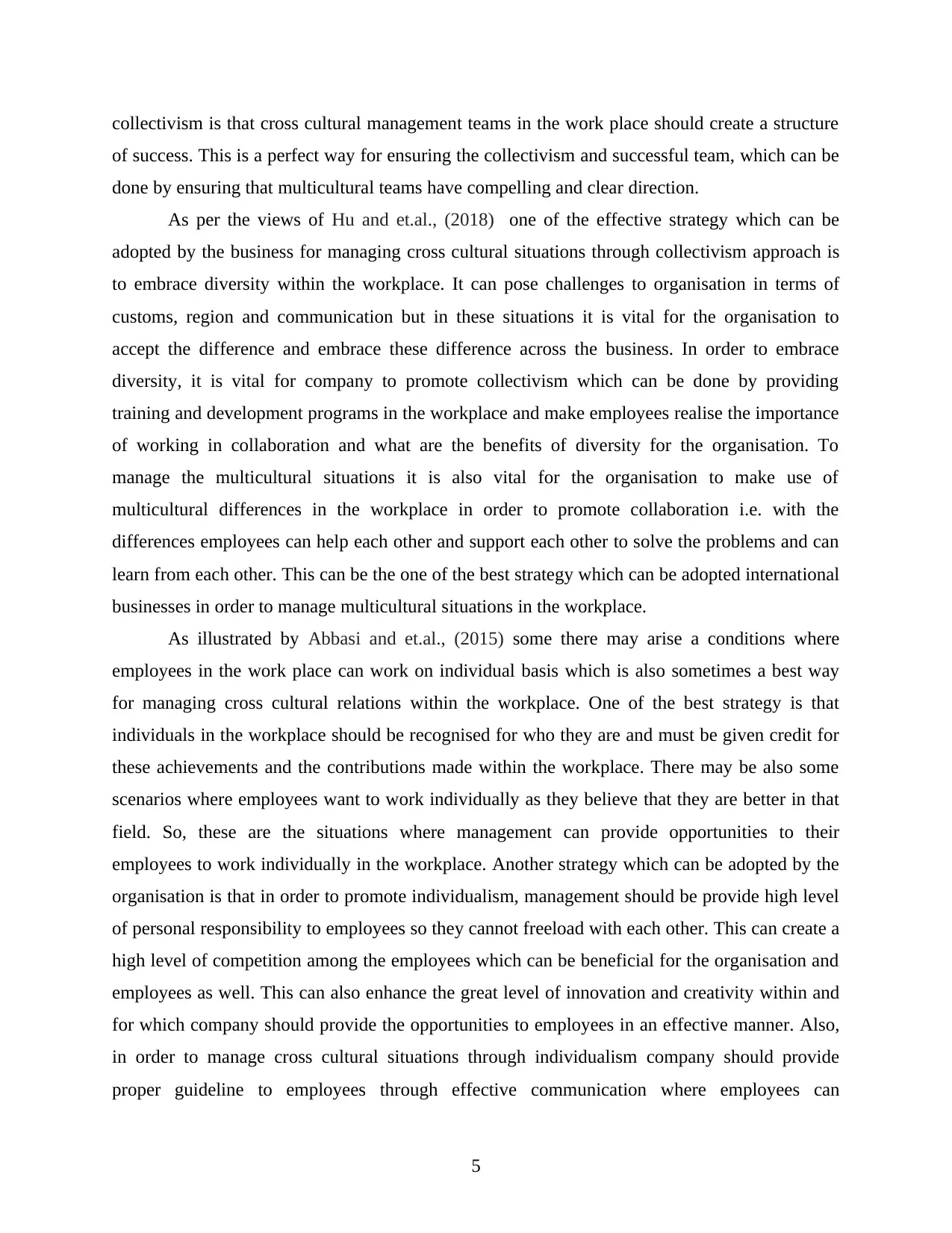
collectivism is that cross cultural management teams in the work place should create a structure
of success. This is a perfect way for ensuring the collectivism and successful team, which can be
done by ensuring that multicultural teams have compelling and clear direction.
As per the views of Hu and et.al., (2018) one of the effective strategy which can be
adopted by the business for managing cross cultural situations through collectivism approach is
to embrace diversity within the workplace. It can pose challenges to organisation in terms of
customs, region and communication but in these situations it is vital for the organisation to
accept the difference and embrace these difference across the business. In order to embrace
diversity, it is vital for company to promote collectivism which can be done by providing
training and development programs in the workplace and make employees realise the importance
of working in collaboration and what are the benefits of diversity for the organisation. To
manage the multicultural situations it is also vital for the organisation to make use of
multicultural differences in the workplace in order to promote collaboration i.e. with the
differences employees can help each other and support each other to solve the problems and can
learn from each other. This can be the one of the best strategy which can be adopted international
businesses in order to manage multicultural situations in the workplace.
As illustrated by Abbasi and et.al., (2015) some there may arise a conditions where
employees in the work place can work on individual basis which is also sometimes a best way
for managing cross cultural relations within the workplace. One of the best strategy is that
individuals in the workplace should be recognised for who they are and must be given credit for
these achievements and the contributions made within the workplace. There may be also some
scenarios where employees want to work individually as they believe that they are better in that
field. So, these are the situations where management can provide opportunities to their
employees to work individually in the workplace. Another strategy which can be adopted by the
organisation is that in order to promote individualism, management should be provide high level
of personal responsibility to employees so they cannot freeload with each other. This can create a
high level of competition among the employees which can be beneficial for the organisation and
employees as well. This can also enhance the great level of innovation and creativity within and
for which company should provide the opportunities to employees in an effective manner. Also,
in order to manage cross cultural situations through individualism company should provide
proper guideline to employees through effective communication where employees can
5
of success. This is a perfect way for ensuring the collectivism and successful team, which can be
done by ensuring that multicultural teams have compelling and clear direction.
As per the views of Hu and et.al., (2018) one of the effective strategy which can be
adopted by the business for managing cross cultural situations through collectivism approach is
to embrace diversity within the workplace. It can pose challenges to organisation in terms of
customs, region and communication but in these situations it is vital for the organisation to
accept the difference and embrace these difference across the business. In order to embrace
diversity, it is vital for company to promote collectivism which can be done by providing
training and development programs in the workplace and make employees realise the importance
of working in collaboration and what are the benefits of diversity for the organisation. To
manage the multicultural situations it is also vital for the organisation to make use of
multicultural differences in the workplace in order to promote collaboration i.e. with the
differences employees can help each other and support each other to solve the problems and can
learn from each other. This can be the one of the best strategy which can be adopted international
businesses in order to manage multicultural situations in the workplace.
As illustrated by Abbasi and et.al., (2015) some there may arise a conditions where
employees in the work place can work on individual basis which is also sometimes a best way
for managing cross cultural relations within the workplace. One of the best strategy is that
individuals in the workplace should be recognised for who they are and must be given credit for
these achievements and the contributions made within the workplace. There may be also some
scenarios where employees want to work individually as they believe that they are better in that
field. So, these are the situations where management can provide opportunities to their
employees to work individually in the workplace. Another strategy which can be adopted by the
organisation is that in order to promote individualism, management should be provide high level
of personal responsibility to employees so they cannot freeload with each other. This can create a
high level of competition among the employees which can be beneficial for the organisation and
employees as well. This can also enhance the great level of innovation and creativity within and
for which company should provide the opportunities to employees in an effective manner. Also,
in order to manage cross cultural situations through individualism company should provide
proper guideline to employees through effective communication where employees can
5
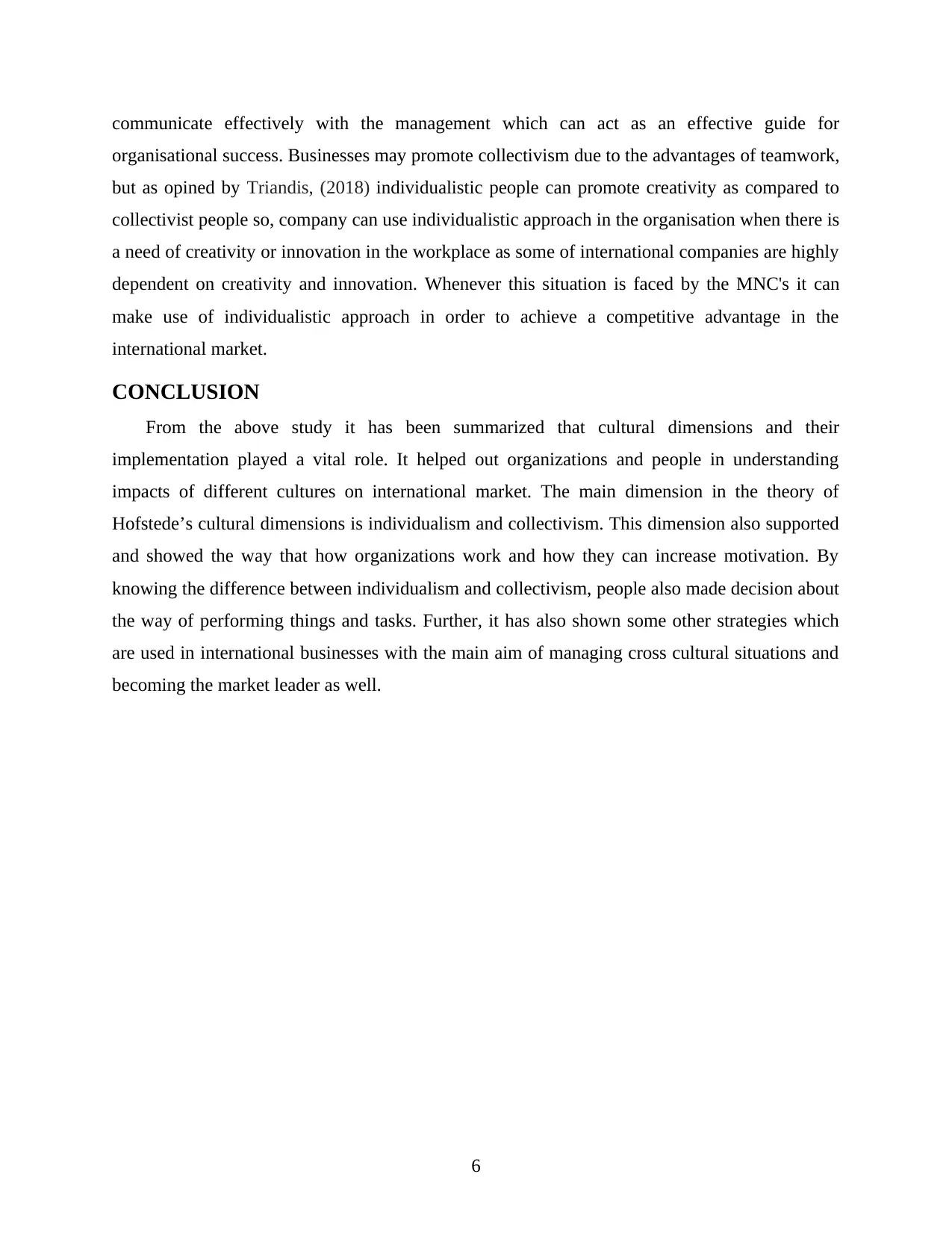
communicate effectively with the management which can act as an effective guide for
organisational success. Businesses may promote collectivism due to the advantages of teamwork,
but as opined by Triandis, (2018) individualistic people can promote creativity as compared to
collectivist people so, company can use individualistic approach in the organisation when there is
a need of creativity or innovation in the workplace as some of international companies are highly
dependent on creativity and innovation. Whenever this situation is faced by the MNC's it can
make use of individualistic approach in order to achieve a competitive advantage in the
international market.
CONCLUSION
From the above study it has been summarized that cultural dimensions and their
implementation played a vital role. It helped out organizations and people in understanding
impacts of different cultures on international market. The main dimension in the theory of
Hofstede’s cultural dimensions is individualism and collectivism. This dimension also supported
and showed the way that how organizations work and how they can increase motivation. By
knowing the difference between individualism and collectivism, people also made decision about
the way of performing things and tasks. Further, it has also shown some other strategies which
are used in international businesses with the main aim of managing cross cultural situations and
becoming the market leader as well.
6
organisational success. Businesses may promote collectivism due to the advantages of teamwork,
but as opined by Triandis, (2018) individualistic people can promote creativity as compared to
collectivist people so, company can use individualistic approach in the organisation when there is
a need of creativity or innovation in the workplace as some of international companies are highly
dependent on creativity and innovation. Whenever this situation is faced by the MNC's it can
make use of individualistic approach in order to achieve a competitive advantage in the
international market.
CONCLUSION
From the above study it has been summarized that cultural dimensions and their
implementation played a vital role. It helped out organizations and people in understanding
impacts of different cultures on international market. The main dimension in the theory of
Hofstede’s cultural dimensions is individualism and collectivism. This dimension also supported
and showed the way that how organizations work and how they can increase motivation. By
knowing the difference between individualism and collectivism, people also made decision about
the way of performing things and tasks. Further, it has also shown some other strategies which
are used in international businesses with the main aim of managing cross cultural situations and
becoming the market leader as well.
6
⊘ This is a preview!⊘
Do you want full access?
Subscribe today to unlock all pages.

Trusted by 1+ million students worldwide
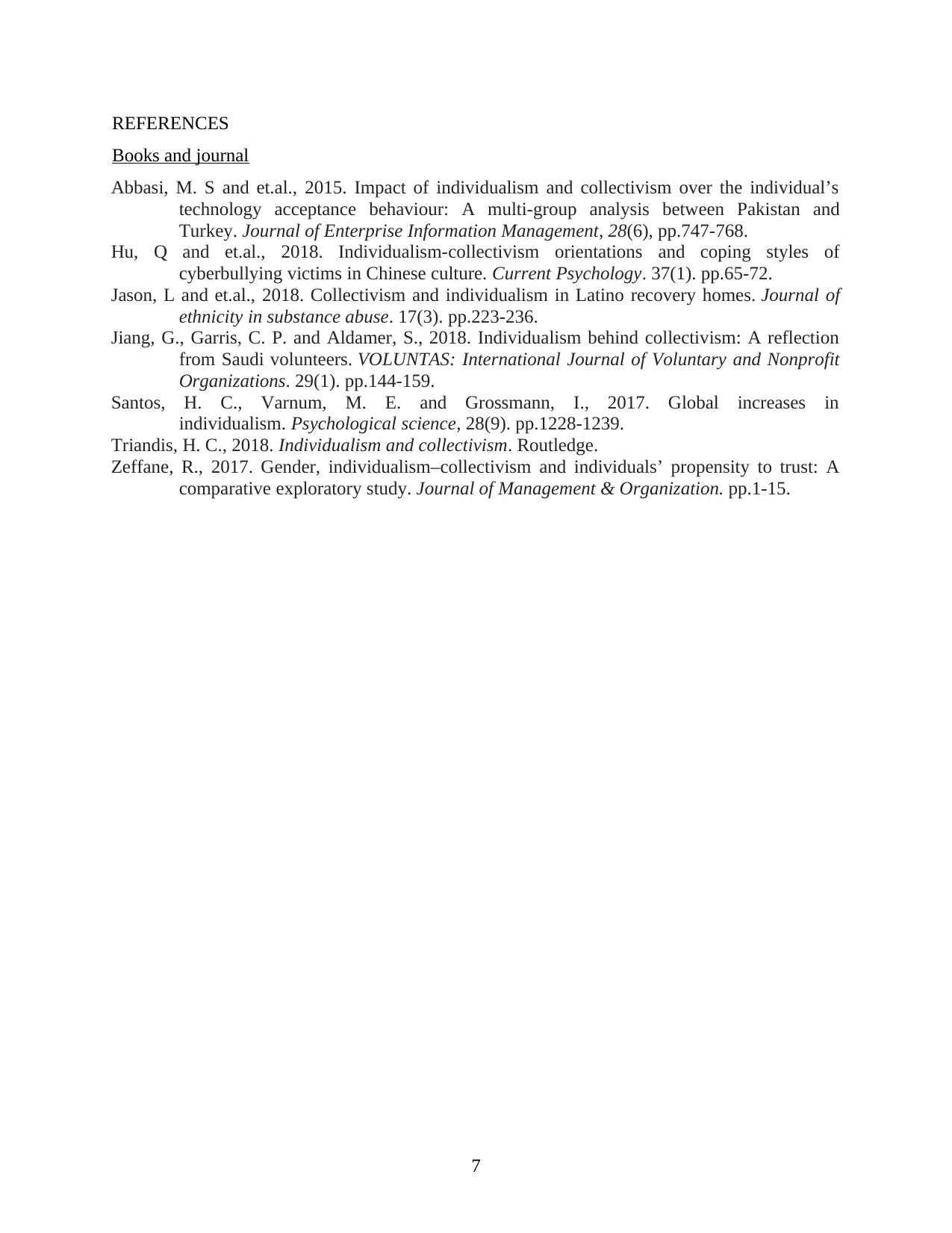
REFERENCES
Books and journal
Abbasi, M. S and et.al., 2015. Impact of individualism and collectivism over the individual’s
technology acceptance behaviour: A multi-group analysis between Pakistan and
Turkey. Journal of Enterprise Information Management, 28(6), pp.747-768.
Hu, Q and et.al., 2018. Individualism-collectivism orientations and coping styles of
cyberbullying victims in Chinese culture. Current Psychology. 37(1). pp.65-72.
Jason, L and et.al., 2018. Collectivism and individualism in Latino recovery homes. Journal of
ethnicity in substance abuse. 17(3). pp.223-236.
Jiang, G., Garris, C. P. and Aldamer, S., 2018. Individualism behind collectivism: A reflection
from Saudi volunteers. VOLUNTAS: International Journal of Voluntary and Nonprofit
Organizations. 29(1). pp.144-159.
Santos, H. C., Varnum, M. E. and Grossmann, I., 2017. Global increases in
individualism. Psychological science, 28(9). pp.1228-1239.
Triandis, H. C., 2018. Individualism and collectivism. Routledge.
Zeffane, R., 2017. Gender, individualism–collectivism and individuals’ propensity to trust: A
comparative exploratory study. Journal of Management & Organization. pp.1-15.
7
Books and journal
Abbasi, M. S and et.al., 2015. Impact of individualism and collectivism over the individual’s
technology acceptance behaviour: A multi-group analysis between Pakistan and
Turkey. Journal of Enterprise Information Management, 28(6), pp.747-768.
Hu, Q and et.al., 2018. Individualism-collectivism orientations and coping styles of
cyberbullying victims in Chinese culture. Current Psychology. 37(1). pp.65-72.
Jason, L and et.al., 2018. Collectivism and individualism in Latino recovery homes. Journal of
ethnicity in substance abuse. 17(3). pp.223-236.
Jiang, G., Garris, C. P. and Aldamer, S., 2018. Individualism behind collectivism: A reflection
from Saudi volunteers. VOLUNTAS: International Journal of Voluntary and Nonprofit
Organizations. 29(1). pp.144-159.
Santos, H. C., Varnum, M. E. and Grossmann, I., 2017. Global increases in
individualism. Psychological science, 28(9). pp.1228-1239.
Triandis, H. C., 2018. Individualism and collectivism. Routledge.
Zeffane, R., 2017. Gender, individualism–collectivism and individuals’ propensity to trust: A
comparative exploratory study. Journal of Management & Organization. pp.1-15.
7
1 out of 7
Related Documents
Your All-in-One AI-Powered Toolkit for Academic Success.
+13062052269
info@desklib.com
Available 24*7 on WhatsApp / Email
![[object Object]](/_next/static/media/star-bottom.7253800d.svg)
Unlock your academic potential
Copyright © 2020–2025 A2Z Services. All Rights Reserved. Developed and managed by ZUCOL.





